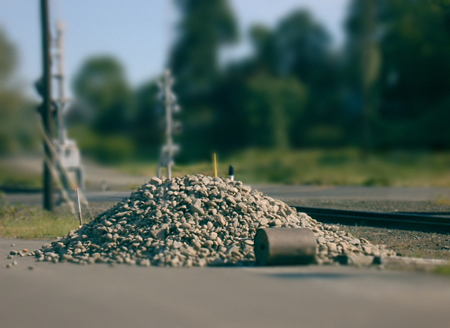
Smallgantics
Encyclopedia

Cinematography
Cinematography is the making of lighting and camera choices when recording photographic images for cinema. It is closely related to the art of still photography...
on full scale filmed sequences – created and developed by Bent Image Lab. The technique was inspired by the tilt-shift photography
Tilt-shift photography
"Tilt-shift photography" refers to the use of camera movements on small- and medium-format cameras, and sometimes specifically refers to the use of tilt for selective focus, often for simulating a miniature scene...
of Olivo Barbieri
Olivo Barbieri
Olivo Barbieri is an Italian artist and photographer of urban environments.He is recognized for his innovative technique creating miniature still photography from actual landscapes by simulating shallow depth of field via the use of tilt-shift lens photography...
.
Definition
Smallgantics is a digital image process that accurately simulates miniature depth of fieldDepth of field
In optics, particularly as it relates to film and photography, depth of field is the distance between the nearest and farthest objects in a scene that appear acceptably sharp in an image...
(DOF) on full-scale filmed subjects via a "hand-made" digital application. Artificial depth planes, up to 8 layers, are generated by the artist, which distort with each frame of a sequence, giving the artist complete control of a simulated miniature DOF scenario.
Technical Explanation
In comparison to Smallgantics, tilt-shift photographyTilt-shift photography
"Tilt-shift photography" refers to the use of camera movements on small- and medium-format cameras, and sometimes specifically refers to the use of tilt for selective focus, often for simulating a miniature scene...
is a photography technique that can be used to give footage - still and motion - the illusion of miniature DOF, but it is not an accurate representation. Using a tilt lens the plane of focus can be tilted between the front of the lens and the film plane of the camera, making the top and bottom, or both sides of the image drop focus. Usually the same lens has both tilt and shift capability but only tilting is needed for the miniature effect.
With tilting, the top and bottom of tall buildings/objects often appear incorrectly out of focus because the blurring of the image is not based on the distance from the lens to the subject, as true DOF does. To accurately recreate miniature DOF with full-scale cinematography, depending on the distance to, and the scale of your subject, one would require a lens in the magnitude of 1000mm+ with a massive glass surface large enough to visually encompass the entire subject.
With Olivo Barbieri
Olivo Barbieri
Olivo Barbieri is an Italian artist and photographer of urban environments.He is recognized for his innovative technique creating miniature still photography from actual landscapes by simulating shallow depth of field via the use of tilt-shift lens photography...
's method, which also tricks the eye into seeing a real landscape as miniature via the shift-tilt method, certain objects in the frame betray the illusion. For example: a telephone pole extending vertically from the bottom to the top of frame will appear soft focus at the bottom, sharp focus in the middle and return to soft focus at the top. In reality, because the telephone pole is within a single plane in 3D space, the degree of focus should remain constant from top to bottom - this is what Smallgantics attempts to accurately simulate.
Process
The Smallgantics process begins with artists creating as many as eight planes of z-bufferingZ-buffering
In computer graphics, z-buffering is the management of image depth coordinates in three-dimensional graphics, usually done in hardware, sometimes in software. It is one solution to the visibility problem, which is the problem of deciding which elements of a rendered scene are visible, and which...
over live-action footage, on a frame by frame basis, resulting in an animated black and white matte
Matte (filmmaking)
Mattes are used in photography and special effects filmmaking to combine two or more image elements into a single, final image. Usually, mattes are used to combine a foreground image with a background image . In this case, the matte is the background painting...
sequence. The artist draws these matte sequences around each object in the scene then assigns z-plane focus parameters. Larger objects may have to be subdivided between z-planes because their depth falls into multiple planes of focus. These depth mattes are then seamlessly blended together with varying degrees of blur, creating the effect of a shallow depth of field. A more sophisticated use of the Smallgantics technique allows the animator
Animator
An animator is an artist who creates multiple images that give an illusion of movement called animation when displayed in rapid sequence; the images are called frames and key frames. Animators can work in a variety of fields including film, television, video games, and the internet. Usually, an...
/compositor to rack, or change, focus within the image over time.
Reference
The shift-tilt reverse Scheimpflug principleScheimpflug principle
The Scheimpflug principle is a geometric rule that describes the orientation of the plane of focus of an optical system when the lens plane is not parallel to the image plane. It is commonly applied to the use of camera movements on a view camera...
has been used for more than a decade, making Smallgantics a computer generated variation of an existing optical technique.
History
Smallgantics was created by Bent Image lab and used for the first time in a series of helicopter sequences in the Thom YorkeThom Yorke
Thomas "Thom" Edward Yorke is an English musician who is the lead vocalist and principal songwriter for Radiohead. He mainly plays guitar and piano, but he has also played drums and bass guitar...
music video "Harrowdown Hill", directed by Chel White and produced at Bent Image Lab.
Example
 |
 |

